
Nick Fancher’s latest book, Studio Anywhere 2: A Photographer’s Guide to Shaping Hard Light, is the perfect guide for the photographer looking to understand and control a range of lighting situations, especially those involving a speedlight or two. With practical instructions, plentiful technical details, real-world business advice, and beautiful photographs, Mr. Fancher gives his readers a text to return to again and again for instruction and inspiration. If you’re just getting started with your new speedlight or you’re looking for unique ways to push your lighting limits, pick up Mr. Fancher’s latest title now.
Available in print and as an e-book, Studio Anywhere 2 is Mr. Fancher’s self-published follow-up to Studio Anywhere: A Photographer’s Guide to Shooting in Unconventional Locations, his 4,000-copy-selling guide to creating studio-quality portraits outside of a traditional studio. (Studio Anywhere has been mentioned on the Improve Photography network here and here.) Mr. Fancher is based in Columbus, Ohio, where he focuses on portrait and commerce photography. He has shot for such clients as Bath & Body Works, IBM, JackThreads, and Victoria’s Secret. Among his publishing credits are ESPN Magazine, Rangefinder, Forbes Japan, and The New York Times.
Mr. Fancher is a minimalist photographer. He’s a “run-and-gun” photographer who operates with little gear. For many shoots, he only uses a full-frame camera, two lenses (a 35mm and an 85mm), and a speedlight or two. As such, his style and his text are perfect for the beginning photographer who doesn’t have much gear and operates on a tight budget. In fact, Mr. Fancher’s modus operandi comes from his roots as a struggling photographer. As a budding photographer ten years ago, he started with a bare-bones setup and learned to push his gear to its limits. Most of the examples in Studio Anywhere 2 can be attempted with little more than a camera and a speedlight. Don’t be fooled by the simplicity, though; with experience on his side, Mr. Fancher sets the bar high with experimentation, vision, and style.
What strikes me most about Studio Anywhere 2 is Mr. Fancher’s willingness to experiment. If he sees a fence or window blinds or a striking mix of shadow and light, he won’t hesitate to see if it works for an image. He’ll hack his speedlight with a foam-board snoot or create a Martin Schoeller-esque setup with star- or triangle-shaped catchlights. In a world that tends to value conformity, Mr. Fancher uses Studio Anywhere 2 to teach how thinking differently can result in unique, quality images.
What Makes This Book Worthwhile
Studio Anywhere 2 progresses from a basic use of ambient light to using speedlights to combining both to adding bounce flash, colored gels, gobos, and more. With 11 chapters, including an introduction and an epilogue, Mr. Fancher’s organization of the text is one of its strongest features. Each chapter builds upon the skills of the previous chapter. There’s a logical progression in skill and technique such that even a beginning photographer can quickly emulate Mr. Fancher’s technique and build knowledge.
Each chapter explains multiple situations where Mr. Fancher created a portrait or product image. With the written explanation, Mr. Fancher also includes a behind-the-scenes photo of the session, showing where the subject and the light was placed. Mr. Fancher then provides the RAW image file and a bird’s-eye-view diagram of the set-up, including camera and flash settings. More often than not, Mr. Fancher also includes Lightroom or Photoshop screenshots to show exactly how he tweaked the initial RAW image. Finally, of course, Mr. Fancher will provide the final image.
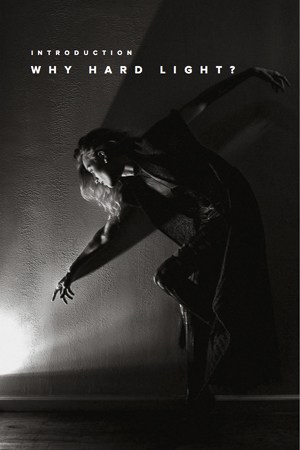
To get so much information for each scenario (written descriptions, behind-the-scenes photos, RAW images, diagrams, settings, Lightroom and Photoshop screenshots, and published images) really makes this text a worthwhile purchase. Mr. Fancher ensures that there is no guess work for you once you put the book down and take out your camera to experiment.
The first three chapters set the foundation for working with ambient light and flash. Mr. Fancher details scenarios and setups that require you to pay more attention to your surroundings rather than your gear. You’ll notice quickly that one of Mr. Fancher’s most valuable skills is that of observation. He sees interesting light everywhere, especially where you wouldn’t at first expect it. Where one photographer might be frustrated to shoot a portrait indoors at night, Mr. Fancher puts his speedlight outside a window and creates daylight, using the window to diffuse his flash much like it would diffuse the sun.
Throughout the text, Mr. Fancher also shows you what didn’t work for him. He provides examples of his test and RAW images as he experiments to get the look he’s going for. He describes his thought process clearly and explains why one image is okay and one is much better. For example, in Chapter 2, Mr. Fancher walks you through the process of creating an “invisible black” background, a technique whereby you create a black background without actually having one. Through a progression of four images, Mr. Fancher shows you how he experimented and tweaked his process to ultimately end up with an invisible black background.
As the chapters progress, skills and technique get more complicated. Mr. Fancher walks you through how to light a scene in a tight space, how to fake the sun when you don’t have it, how to play with long exposures, and how to create compelling shadows. He even delves into light painting a dancer moving across a dark scene. Despite the difficulty of the technique, Mr. Fancher makes sure that even the most complicated situation gets a full explanation. He also readily admits that he doesn’t always get it right at first. For me, that’s a strength of the text: his attitude of trial-and-error, try it ‘til it’s right.
The final chapters focus on what really exemplify Mr. Fancher’s current style: shadow, color, and shape. If you browse his website or his Instagram account (@nickfancher), you’ll get a clear idea of what he likes to create: high drama, dark palettes, and stark compositions. Mr. Fancher’s style is for the artist, the musician, the actor, which isn’t for everyone. But it is distinctly Nick Fancher, which is why many readers will be attracted to his work and this text.
Mr. Fancher spends some time in the later chapters working with his current favorite color combination: cyan and red. You’ll recognize the colors if you remember old-school 3-D movies. You’ll see how he plays with shadow as well as main-versus-accent color. For someone looking to break out of a photography rut, trying to see what you can create with the cyan-and-red combination will be a great experiment.
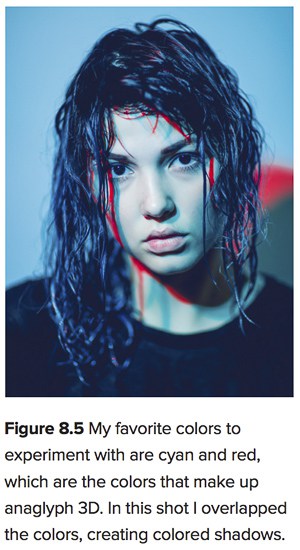
What’s especially worthwhile in one of the later chapters is Mr. Fancher’s description of additive light. With a little color theory and more of Mr. Fancher’s experimentation, he details how to create images with colored shadows while maintaining a white light on your subject. Again, the setup is simple: a camera, three speedlights, and colored gels. But the image is striking and modern.
As a family photographer, I don’t really do much of what Mr. Fancher showcases from day to day; however, I am certainly inspired by his inventiveness and style. I use his texts to push myself to move beyond the standard natural-light or umbrella-at-45-degrees portrait. Granted, I know Mr. Fancher adeptly creates less dramatic photos for many of his clients (corporate headshots, products, weddings, etc.), but I don’t think of his preferred style as safe, standard, or sanitized–he pushes boundaries and ups the drama and tension.
Overall, the chapters of Studio Anywhere 2 are honest, specific, and inventive. Mr. Fancher details each scenario from conceptual inspiration to technical specifics to editing to publishing. While for some readers there may be moments that dwell on certain details and others that are colloquially out-of-place, Mr. Fancher moves the text along fast enough that the most critical reader will forgive a slight unevenness in style.
As a bonus, Mr. Fancher writes several “Pro Tips,” which are small essays on a specific topic like finding inspiration or smartphone photography. He also ends some chapters with a “Making a Scene” challenge. Each challenge starts with a photo of a location and a situation (you’re in a hallway with several offices nearby and your job is to “Shoot a dramatic portrait of the subject”). The challenge then asks you to consider where you would place the subject and your light(s). Flipping to the back of the book gives you Mr. Fancher’s thoughts and the resulting image.
If you’re trying to decide between the e-book and the print version, I’d say buy the book in print. I’ve spent time with both; in fact, I’ve spent more time with the e-book version, and I’d still go with a print copy. The e-book is really only a basic PDF file. There aren’t functional links to make going from section to section any easier, and you can’t bookmark pages to return to later. You simply scroll up and down as you explore the 200+ pages. I find it much easier to browse back through sections with the print version. Also, the print version showcases Mr. Fancher’s layout and design prowess that much more. He has paid real attention to how the open book looks on each spread. For example, the answer reveal of each “Making a Scene” scenario just works better in print–you get to see the setup and the final image side-by-side rather than vertically separated in the e-book.
In print, you also get a better sense of Mr. Fancher’s progression of ideas and content. I had a tendency to scroll and scroll with the digital version, whereas the print version called for more deliberate attention and reflection. I will say that the digital version showcases Mr. Fancher’s images better than the print version, especially on a high-resolution monitor. (I can’t imagine reading something like this on a phone, though.) While the print quality is good, some of the images get a little muddled, especially if you’re looking for detail in darker tones.
As I’ve said, this book wants to inspire experimentation. The digital version is tougher to go back to and reference, especially if you’re out and about. The print version is 6-inches by 9-inches and a little over a half-inch thick, which makes it as portable as a thick journal. Sure, the book is bigger than your phone, but I’d hate to squint and zoom and scroll on a small screen. You’re going to use this book to experiment. Owning the print version will make that easier. Don’t forget to hashtag your images with #studioanywhere. Mr. Fancher follows his hashtag frequently, and he may just comment back with kudos.
Example with Ambient Light
Here’s an example of Mr. Fancher’s inventiveness and skill. At the end of chapter 1, “Shaping Available,” he gives a “Pro Tip,” calling for you to “hack your reflector”. Mr. Fancher writes that “[t]his is the cheapest yet most effective photography hack I can think of.” Essentially, what Mr. Fancher suggests is that you cut a camera lens-sized hole in the middle of your reflector. He explains that the material of most reflectors is tough enough that the hole won’t spread, and he notes that the reflector can still be used as normal. (He admits, though, that the downside of this hack comes when you need to use the reflector to block the sun.)
Why cut a hole in the middle of your reflector? Mr. Fancher explains that you can shoot through your reflector, which now acts like a ring light, which will give you even front-light. The great part about this hack is that you don’t need a second person to hold your reflector. The reflector will simply rest on your lens while you operate your camera as you always do.
Along with the text of this hack, Mr. Fancher provides a written description, a RAW image, a diagram with settings, Lightroom screenshots, and a final image. You’ll notice that Mr. Fancher also placed his subject against a small slice of wall between two giant windows. Not only does his setup benefit from the initial natural light from both sides acting as a rim light, but his hacked reflector fills in the subject beautifully. The final image is proof-positive that this hack is worthwhile.
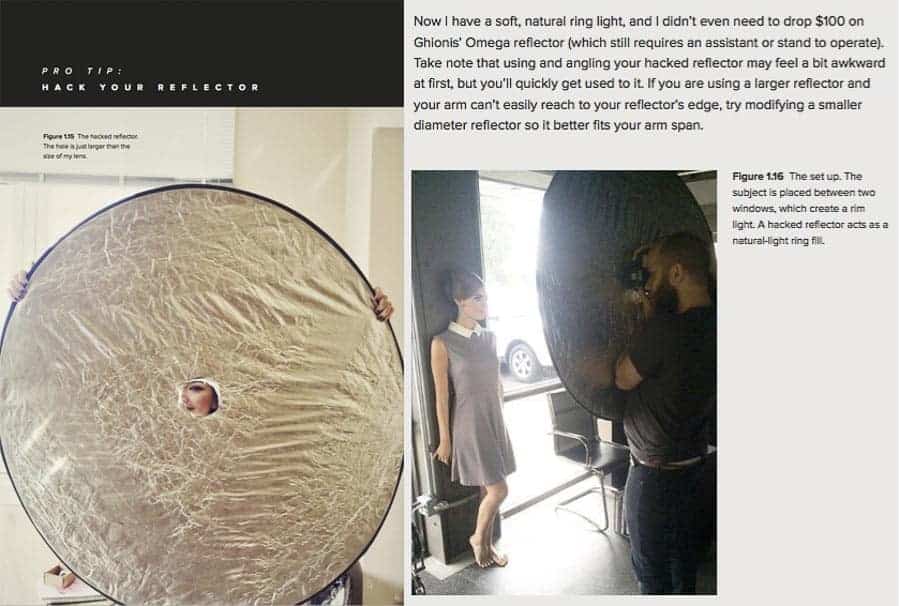
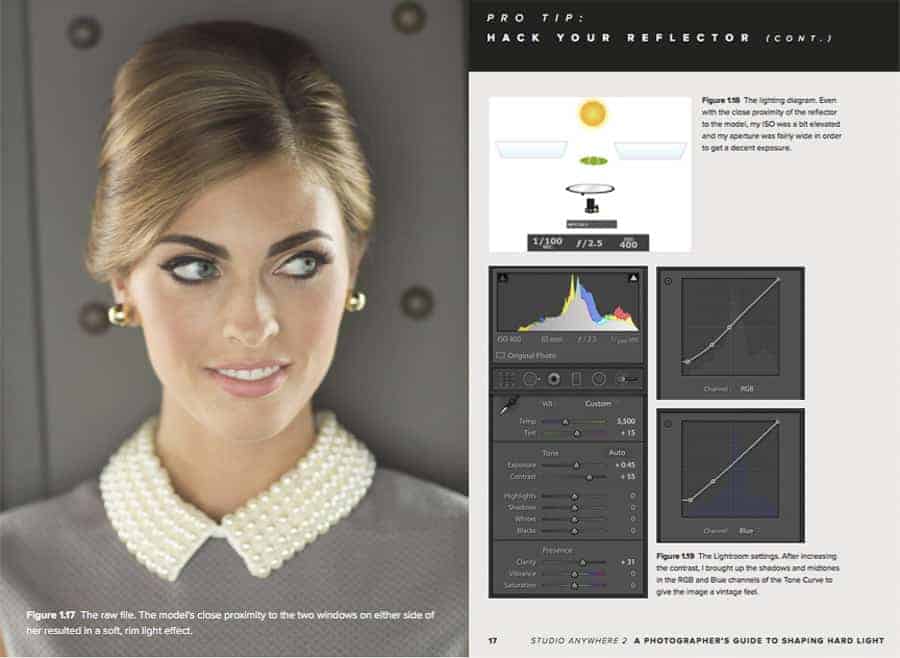

More Pro Tips
Two of Mr. Fancher’s “Pro Tips” especially caught my attention. At the end of Chapter 5, Mr. Fancher writes a “Pro Tip” essay about finding inspiration. Mr. Fancher’s essay isn’t filled with the usual advice like “be yourself” or “learn something new each day” or “get out of your comfort zone”. Instead, Mr. Fancher describes how low he felt once he discovered the portfolios on sites like Flickr and 500px. He writes that “[l]iterally every image on there was better than anything I had shot or even knew how to shoot.” He explains that he was overwhelmed by the beauty, but not in a good way–the images made him feel “tiny”.

But he didn’t see this as a negative in the end. He recognized that the amazing level of skill that’s out there means that he needed to push himself to be better than the already great. How does he push himself? By watching movies or reading Interview Magazine and using the light and style he sees on screen or in print as inspiration. Mr. Fancher’s willingness to fail and push through trial-and-error experimentation results not only in technical knowledge but beautiful portraits earned through time, effort, and vision.
At the end of Chapter 7, Mr. Fancher’s “Pro Tip: Staff versus Freelance” really shines as excellent advice for anyone making decisions about how to set up a photography business. This essay strikes me as exactly the right kind of information for many of the readers of Improve Photography, many of whom are trying to sort out the business world of photography. Mr. Fancher chronicles his journey from his early days after college, how he began to earn money through photography, and how he built a business that suited his particular needs and desires.
He describes the advantages and disadvantages of being a freelance photographer and a staff photographer. He rejoices in the moment when JackThreads, a new, local fashion company hired him to shoot full-time for the company. But he also explains how the JackThreads gig would be a pay-cut in relation to the weddings he had been shooting for the three years prior. Mr. Fancher had to work out just how he would swing his dream of being a staff fashion photographer and continue to make enough money to pay bills and raise a family.
As a side note, Mr. Fancher details how he got the JackThreads job: “You know how the company’s creative director found me? I had shot his wedding a few years prior. Never take any gig for granted, because you’ll never know where it could lead.”
He closes his freelance versus staff “Pro Tip” directly addressing the reader who is beginning a photography company: “…don’t put too much pressure on yourself. Don’t rush the process. The photographers you look up to have been doing this a lot longer than you. You have time to catch up.” Studio Anywhere 2 and its ethos of do-it-yourself experimentation are the perfect place to start catching up.
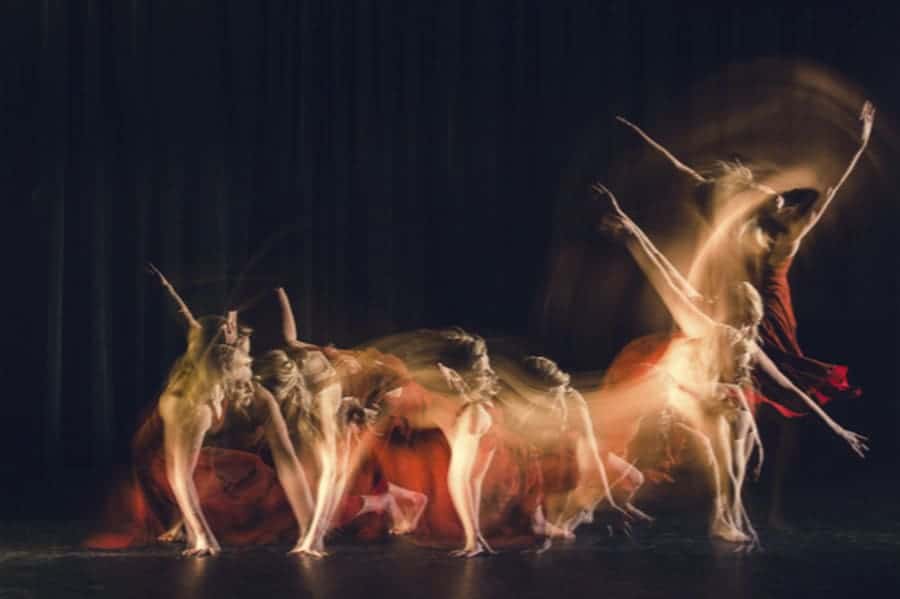
On Location with Nick Fancher
While writing this review, I was lucky enough to visit with Mr. Fancher at his studio in Columbus, Ohio, though the word “studio” is used liberally here. The space is a 10-foot-by-30-foot room with large windows and not much else. Mr. Fancher’s “desk” is two small end tables with a computer, a small shelf of portable hard drives and 1980’s action figures (He-Man, Voltron, and the like). There’s a small wood crate and an leather-studded chest for models to sit on, a seamless white backdrop on the far wall, a chalkboard-painted stretch of wall, and a scuffed antique mirror, which belongs to the wedding dress maker who shares the space. Along the expansive ledge under the windows is Mr. Fancher’s book and magazine collection–a stack of Interview Magazine, two dozen photography books, and some copies of his published material. I sat in a small leather executive chair he has for guests.
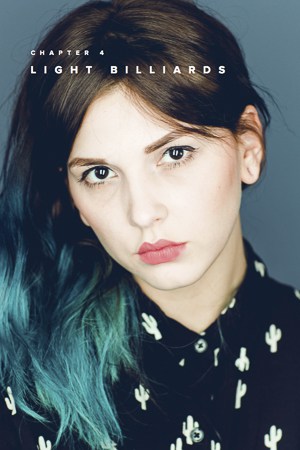
Wearing a black t-shirt and jeans, Mr. Fancher was browsing a playlist when I arrived to observe his test shoot with a local model. We chatted about our kids, things to do in Columbus, his favorite shooting locations, and whatever else came up. Reading both of his Studio Anywhere texts, I get the impression that he’s a down-to-earth guy, always willing to share, a believer in personal connection. In person, he’s exactly that.
When the model arrived for Mr. Fancher’s Tretchikoff-inspired session, Mr. Fancher was gracious and kind. He asked “What’s new with you?” and listened while she talked about the new professional and personal developments in her life. As they chatted, Mr. Fancher browsed the bag of outfits, wraps, and accessories the model brought. With relaxed care, they decided on a look together. The first ten minutes were low-pressure and easy-going.
As the model changed in a room next door, I witnessed another great “Pro Tip”: a portable clothes steamer. No bigger than a hair-dryer, the portable steamer would “save retouching later”. While the model changed in a room next door, Mr. Fancher spent a few minutes steaming-out the wrinkles in a white top. This moment was the first window into his meticulous, detailed mind. I imagine that many observers might get the impression that Mr. Fancher is nonchalant or ambivalent, but his casual exterior compliments an attentive interior.
As hip-hop played low in the background, Mr. Fancher began to test his light. He worked with a speedlight on a stand and a speedlight on his camera. The stand was modified with a Cactus CB-60W softbox, and his on-camera flash was modified with the Neewer Roundflash. Within five minutes, Mr. Fancher progressed from the softbox gelled red on camera right at 45-degrees to the softbox providing sidelight camera right followed by a switch to camera left then no softbox then to a homemade set of barndoors to switching the gels entirely. He worked quickly and quietly, like a kid trying out the right series of Legos to build his next masterpiece.
After no more than six or seven minutes, Mr. Fancher said, “We’re live now.” Both he and the model were now creating rather than testing. With a simple “great” or “beautiful” or “I love that,” he praised the model, keeping things relaxed and fast-paced. With each click of the shutter, the model shifted and Mr. Fancher tried a slightly different perspective. With efficiency and vision, Mr. Fancher went from inspiration to final image in no time.
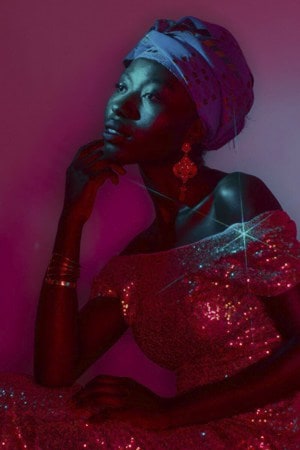
What I’m struck most by as I think back on the portion of the session I observed was how calming and relaxed Mr. Fancher was with the model compared to the ever-changing, ever-evolving experimentation of his lighting. You’d never know if he was displeased or frustrated by anything. To have calmness and confidence while experimenting and creating is undoubtedly an asset and a reason for Mr. Fancher’s success.
Final Thoughts
Here’s why you should get this book: Nick Fancher is honest and straight-forward. He doesn’t sugar-coat his images or the world of professional photography. He writes with a playful frankness that is fun to read. Mr. Fancher is also incredibly generous. He provides detailed written descriptions, behind-the-scenes photos, RAW images, diagrams, settings, Lightroom and Photoshop screenshots, and published images for a ton of scenarios and setups. Mr. Fancher provides a model attitude for how to get better as a photographer: make the most of your gear, experiment, and work harder than the competition. A read through Studio Anywhere 2: A Photographer’s Guide to Shaping Hard Light will undoubtedly inspire you to go out there and shoot.
Nick Fancher’s self-published Studio Anywhere 2: A Photographer’s Guide to Shaping Hard Light is available in print for $32.99 (plus shipping) and as an e-book for $15.
(Full disclosure: in preparation for this review, Mr. Fancher sent me a pre-publication copy of Studio Anywhere 2. He casually asked me to let him know if I saw any writing errors. I'm a high school English teacher by day and he was self-publishing the book, so I thought, “Why not?” Plus, I'd been a fan of his already and thought it would be cool to be involved on some small level. I did a read-through and helped as much as I could. Nick kindly gave me an acknowledgement in the book. This review is independent of Mr. Fancher and his photography business.)
For those who need expert writing assistance SmartWritingService – book summary helper can be a good solution.

Gorgeous Outfits. COVER IMAGE. PHOTO is beautiful.
Regards
Savita
Aaron,
Great review. I have been eyeing the first book for some time now. Do you recommend getting through the first one before reading the 2nd? Or does the 2nd one stand on its own?
Hey there Pete,
Each book can stand alone. The first text is split up by location ideas, whereas the second is split by lighting techniques. The intro of the first text gives a great breakdown of how different flash settings and how different modifiers affect your light. Both are great texts–I’d just get both! 🙂 The first text also has more product photography, in case that interests you.
Enjoy!
Nice blog. This is a very good blog on tips. I would like to thank you for all the information you give. Its really important to choose the best healthy tips to maintain your Fitness. So thanks for the information you give.
It’s incredible what a person can do from ordinary photography!
Such changes excite the imagination. After all, you can make a different person from a person, the photo can show exactly what you want to see on it. I’m working as a freelancer for college newspaper site and I write to our client work on new design technology. Thank you for the amazing article that helped me a lot!
Thanks for the information.
It’s a really great article! https://improvephotography.com/